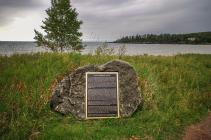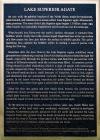Inscription
LAKE SUPERIOR AGATE
As you walk the pebbled beaches of the North Shore, watch for translucent, color-banded, and reddish-brown stones called Lake Superior agate--Minnesota's state gemstone. The story of the Lake Superior agate begins 1.1 billion years ago, when basaltic lava repeatedly erupted here and flowed out over the landscape.
When basaltic lava flows over the earth's surface, the gases it contains form bubbles, which slowly rise in the viscous liquid. Rapid heat loss at the top surface of a flow causes the lava just below the surface to solidify quickly. This quick-hardening lava captures the bubbles within it, creating a zone of porous rock along the flow top.
Sometime after the lava flows in the Lake Superior region solidified, warm groundwater containing varying dissolved chemicals percolated through the basalt, especially through the porous zones, and lined the gas cavities with layers of different minerals until the cavities were filled. A common cavity-filling mineral is called chalcedony, which is a type of quartz with microscopic crystals shaped like fibers. When chalcedony is color-banded, it is known as agate. The colored bands are due to small amounts of impurities (such as iron, copper, and aluminum) that are precipitated cyclically in every other layer of the fibrous quartz. In the layers receiving impurities, the quartz fibers formed are thinner and twisted. The center of an agate is often filled with coarsely crystallized quartz.
Since the time that agates and their basalt hosts formed, this continent has drifted very slowly several times across tropical climate zones, by a global process called plate tectonics. Under tropical conditions, intense chemical weathering caused the basalt to break down, but not the more resistant agate.
By the time the Ice Age began, about two million years ago, basalt flows near the surface of the land were very weathered, weakened, and rich in hard agate nodules. As enormous glaciers advanced from the north and scoured the Lake Superior basin, they ground away the basalt and picked up the agates, transporting some as far away as Kansas. Many agates in Flood Bay may actually have been carried from areas in Ontario, where similar rocks are found.
Transportation, the Minnesota Geological Survey, and the Minnesota Department of Natural Resources 2009
Details
| HM Number | HM2BIT |
|---|---|
| Additional Information | See the Geological Society of Minnesota's Web Page for this Marker for further info. |
| Series | This marker is part of the Geological Society of Minnesota series, and the Minnesota Department of Highways series. |
| Tags | |
| Historical Period | Pre Columbian |
| Historical Place | Other |
| Marker Type | Other |
| Marker Class | Historical Marker |
| Marker Style | Mounted |
| Marker Number | 230 |
| Year Placed | 2009 |
| Placed By | Geological Society of Minnesota, MNDOT, Minnesota Geological Survey, Minnesota DNR |
| Marker Condition | No reports yet |
| Date Added | Thursday, September 20th, 2018 at 8:12am PDT -07:00 |
Pictures
Photo Credits: [1] MARTHA DECKER [2] MARTHA DECKER
Locationbig map
| Location Description | This marker is located off of the SW end of the lot at the Flood Bay State Wayside. |
|---|---|
| UTM (WGS84 Datum) | 15T E 603129 N 5210313 |
| Decimal Degrees | 47.03829000, -91.64251200 |
| Degrees and Decimal Minutes | N 47° 2.2974', W 91° 38.5507' |
| Degrees, Minutes and Seconds | 47° 2' 17.8440" N, 91° 38' 33.0432" W |
| Driving Directions | Google Maps |
| Can be seen from road? | No |
| Is marker in the median? | No |
| Which side of the road? | Marker is on the right when traveling North |
| Closest Postal Address | At or near , , |
| Alternative Maps | Google Maps, MapQuest, Bing Maps, Yahoo Maps, MSR Maps, OpenCycleMap, MyTopo Maps, OpenStreetMap |
Is this marker missing? Are the coordinates wrong? Do you have additional information that you would like to share with us? If so, check in.
Nearby Markersshow on map
Show me all markers in:
World War I German Cannon
50th Anniversary of First Shipment of Iron Ore From Minnesota
Thomas Owens Memorial Park
John Dwan Office Building
Duluth and Iron Range Depot
Hand Car, Velocipede, Sleigh, Station Wagon
D&IR Railroad Company Sleigh
First Ore Taken From A Minnesota Mine
First Ore Taken From A Minnesota Mine
Ore Car #251, 1884 & Bobber Caboose #22 (#52), 1893
Maintenance Issues
- What country is the marker located in?
- This marker could use another picture or two.


Comments 0 comments